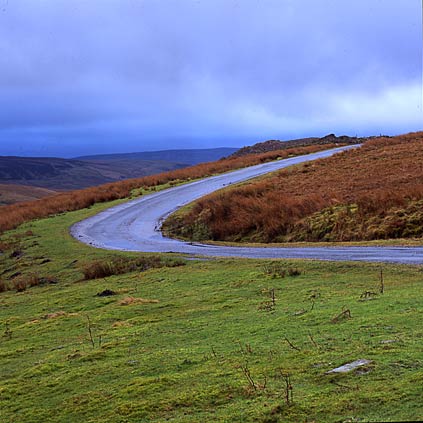

I planned to write an article about the way I work, in terms of equipment, travelling, film, exposure, etc. etc. Similar to the Scotland, camping with a Bronica 6x6 article or in the landscape & nature - technique section, but this time a more systematic and elaborate article.
I thought about all the things I wanted to say. Should I start with the equipment, or travelling or what do I do with all those photographs? I couldn't find an order that wholly satisfied me.
And a lot of people have written equipment reviews and told about their experience with film far better than I can. I am not so much a
traveller, that I could give anyone advice - apart from a recommendation to go to the places I have come to love.
The backbone of what I want to say is simple: describe what I do as a landscape photographer. Looking about in places I like, seeing things that strike or move me, reacting by making a picture of it, showing my photos to those who like to see my efforts.
So this is an article about looking, seeing, reacting and showing. No talk about specific equipment, special techniques or which brand has the better optics.
I hope you'll gain some insight in what this particular photographer sees as his craft and art.
The photographic circle starts by being there - or even earlier: choosing a destination for a photographic trip (or deciding to take a camera with me when I go somewhere).
Whether I take a camera with me or not depends on a few things: is it likely that I will see something worth making a picture of? Will I have time to work on a picture?
When for example I go to town to do some shopping or to see someone, I won't take my camera with me. Urban areas, at least the ones here in Holland, don't have my photographic attention. I will have my eyes open, but will not look as a photographer.
 As soon though as I do a wedding in town, my eyes are fully opened to telling the story, the photographic possibilities of the place.
As soon though as I do a wedding in town, my eyes are fully opened to telling the story, the photographic possibilities of the place.
And at the time I will start to work at my Leiden portfolio (a plan I have had for years, but never found the courage to actually start with) I will have another way of looking than when I have buying new shoes in mind.
The holidays are to a large extent used for photography. This year we'll have a two weeks holiday in Scotland. We plan to go to the Isle of Mull and some nearby islands, Iona and Staffa. As I have already been there before, I more or less know what to expect and to look for.
Whilst there I will of course look around. Be aware of my surroundings, not only visually but with all my senses. Open eyes, open mind.
Open to visual experience.
But evidently one cannot be open to all incoming information! When on holiday my attention goes to the landscape - its colours, texture, features, the evidence of a long history. As I shoot slides, I look for colours. Also for subjects that will fit into a series of images.
That is also the reason why mixing black & white and colour photography at one time is difficult for me. My eyes can't be open for both at the same time.
Along the same lines I shoot very few family pictures on holiday as well. But I can shoot lots of them at a trip to the zoo, as I am not into wildlife.
So looking is about directing my attention, concentrating on what I hope to find.
Without open eyes and an open mind one cannot see anything. One can't expect to
bump into some attractive scene without really looking.
Of course, one can see surprisingly beautiful or striking things at the most unexpected places, even when one's mind was directed to driving home.. But for good photographic work, one needs concentration.
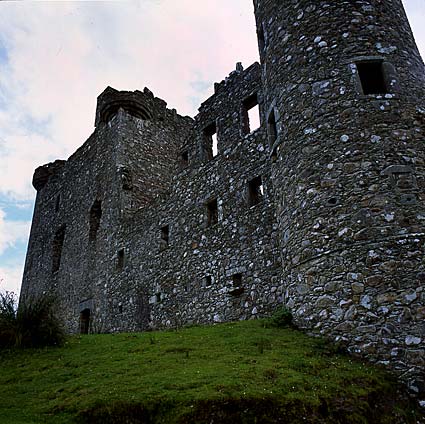 But I find that concentration is not enough. The more often I visit a place the better my pictures. The more I know about for example Scotland and its geology, biology and history, the more I see - and the more I understand what I am looking at. And equally important: that knowledge has deepened the emotional link to the country, which makes my photography more meaningful and personal as well.
But I find that concentration is not enough. The more often I visit a place the better my pictures. The more I know about for example Scotland and its geology, biology and history, the more I see - and the more I understand what I am looking at. And equally important: that knowledge has deepened the emotional link to the country, which makes my photography more meaningful and personal as well.
But with concentration and a positive relationship with the place where I am, at any time something special can happen - looking around I suddenly see: a scene or feature, typical or in contrast to its surroundings, mysterious or plain, moody or whatever [ see also What is landscape? ] .
It is being impressed by something, which urges me to stop (just ask the people who walk or drive behind me!) and take a better look. Listening to the things it has to say to me and responding emotionally.
This may sound a bit too psychological to some, but I think it is what happens to most photographers. Reacting emotionally and building a relationship to the subject.
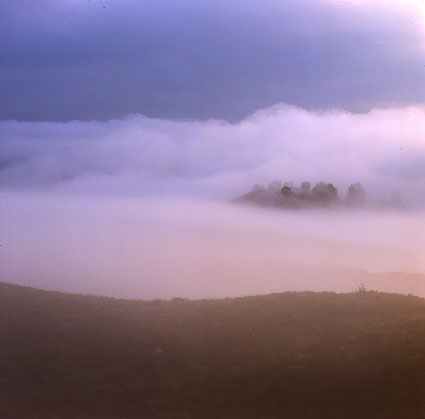
I like to call this the impressionistic side of photography. What I see urges me to make a photograph of it, showing its character.
It is hard to put into words why some things are more striking to me than others, but it certainly has to do with a connection between what I am looking for (consciously and on a more emotional level) and what my eyes see. Things that match my inner feelings of hope, fear, desire, horror. Things that move me as being beautiful, a reference to their Creator, or as still and sad, like derelict houses or recently cleared forest.
Which brings me to the more expressionistic side of the photographic process.
The expressionistic side has to do with my inner feelings and thoughts. The way I make pictures is an expression of myself. It shows a part of my character, along with the subject.
Granted, photographers cannot (outside the controlled environment of a studio - and even then) work as mere expressionists. It is impossible for me to convey emotions and thoughts directly into a photograph.
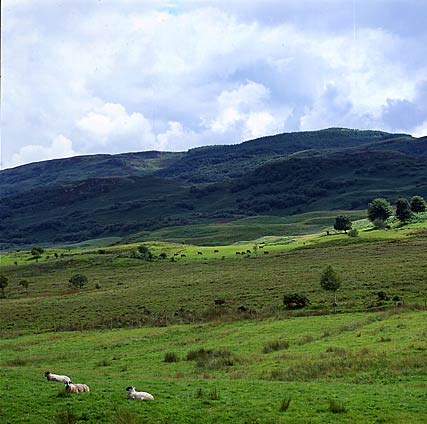 Nevertheless, my work isn't entirely impressionistic either.
Nevertheless, my work isn't entirely impressionistic either.Secondly, though I cannot form the subject the way I want (as a painter possibly can), but I surely can give an interpretation of the subject by photographic means.
These include:
An example of impressionist and expressionist elements in the making of a photograph:
I love Scotland a lot, because of the beautiful scenery, the ever changing skies and light, nature and culture. Photographs I make there directly reflect the impressions the land has on me.
Part of why I love the Scottish highlands so much, is the relationship between nature and the inhabitants of the land - stronger than in densely populated and
urbanised Holland (whether this is true or not - it is a concept I have). I want to show that relationship and express my feeling of happiness when I am in a place closely connected to nature.
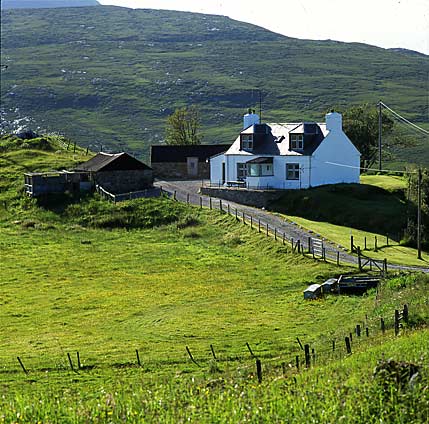 Therefore, as soon as I spot a lovely farmhouse, revealing its history of hard work and its bond with the earth, I want to take a photograph of it. But I cannot express my feelings directly, like a painter could by choosing colours, altering forms and sizes or by omitting the more modern elements of the house.
Therefore, as soon as I spot a lovely farmhouse, revealing its history of hard work and its bond with the earth, I want to take a photograph of it. But I cannot express my feelings directly, like a painter could by choosing colours, altering forms and sizes or by omitting the more modern elements of the house.
This whole process of choosing and framing subjects questions in a way the notion of photographs as reality - although in the schemes of things photography is quite a realistic form of art. [ more on this, see Approaches in landscape photography ]
This however is not the same as to say that the honesty of photography is directly linked to its realism. That depends on the intentions of the photographer.
To me it is of prime importance to work with my own concepts and vision. Copying others' work, however good and beautiful or correct in the eyes of fellow photo club members or magazine readers, can never be the last step in the way to creative art. I enjoy what others do and often I know I will never be able to reach the same level - but being true to myself is the only way forward.
A photograph can only be of any significance if it seen by people - even if it is only the photographer viewing his slides or prints.
It is therefore important to take showing into consideration as well. Photography is a visual art - in the taking of the picture and in the consumption of the art.
For photojournalists or wedding photographers this is very evident. They make photographs because they want to show what happened (although this form of photography can be about creating illusions as well). Glamour photographers are very much aware of their public too, as they want to arouse feelings (about what people would like to happen?).
But for still-life, landscape or nature photographers this is less obvious. They are often the only ones to see their work. (I am not talking about professionals working in these fields, who should know their consumers all too well, or they will be out of business only too soon)
In the process of making landscape and nature photographs I have an audience 1 in mind: people who are going to view the slide shows I am making, mostly friends and some fellow-photographers. Since I have got a website, a lot of people will see my portfolios, thereby widening my audience immensely.
As others told me, the slides and the portfolios have a strong educational concept. Of course I want people to enjoy the images, but the meaning of these series is in showing something about the land, its people and its nature. This is, I guess, the more or less unconscious concept behind my photography indeed.
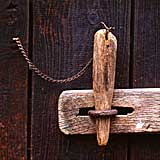 |
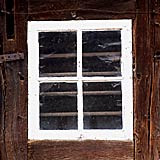 |
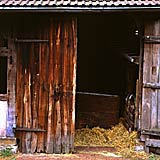 |
By putting photographs in a series, I show (or suggest) relationships between the individual images. Subjects are placed in wider context, like the whole of an eco-system or a crofters' community. This way, a series creates more meanings than the sum of all individual pictures.
The viewer of such a series though has less of a chance to interpret the images on his (or her) own, as the interpretation is more or less given by the progression of photographs in the series. But as I don't make many abstract photographs, I don't see this as a disadvantage. My landscape work is quite documentary after all.
The above scheme of looking, seeing, reacting and showing is not just a linear one. The desire to show slides provides me with a special mindset, looking for things that will do well in the series I am making and which will succeed in colour.
It is simply impossible to just look - every photographer imposes his (or her!) style, his themes, his vision. That will always influence the way he looks and what he sees.
That is why I called the article the circle of photographic life, as all parts affect each other.
I am not saying that one should only pick up the camera with a very specific purpose in mind. Spontaneous photos are very nice - but they are at their best when the photographer was looking and anticipating intensely.
As they say, preparation is the best key to success. So is thinking about what you are doing as a photographer and why you are doing it. It helps you to focus your efforts, to direct your attention.
This all certainly is not a mere intellectual process - to me it is concentrating on what I am doing: being there, looking around, responding to what I see.
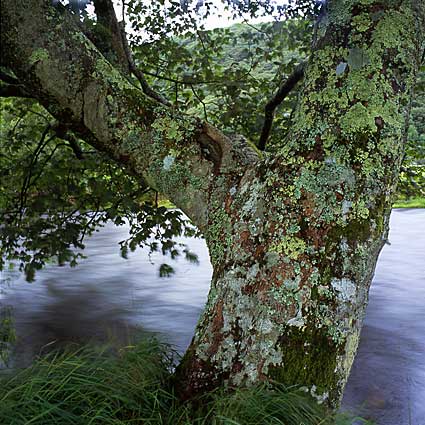
Note 1: I use here the word audience for lack of a better word - photos are rather viewed than listened to, aren't they? May I coin the word vidence here?
<school> Audience is derived from Latin audire: 'to hear', to 'listen'. And videre is in English 'to see'. </school>This article is written by Wim van Velzen, © 2003.
Comments on the article and photographs are welcome!The landscape photographs shown here and lots more are put in several portfolios!
It is also possible to order landscape prints or to use them editorially or commercially.